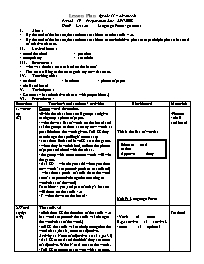Giáo án môn Tiếng Anh 11 - Unit 10 Lesson: Language Focus - grammar - Period 79: Preparation

Lesson Plan (grade 11 – advanced)
Period : 79 Preparation date : 22/1/2008
Unit9 : Lesson : Language Focus- grammar
I. Aims :
- By the end of the lesson, the students are able to use the suffix – al.
- By the end of the lesson, the students are able to use to-infinitive phrases or participle phrase in stead of relative clauses.
II. Lexical items :
- round the clock - poacher
- compulsory - search for
III. Structures :
- who was the first man to land on the Moon?
- The man talking to the manager is my new flat mate.
IV. Teaching aids:
- textbook - handouts - pieces of paper
- chalk and board
V. Techniques :
- Grammar – based (relative clauses with prepositions.)
Bạn đang xem tài liệu "Giáo án môn Tiếng Anh 11 - Unit 10 Lesson: Language Focus - grammar - Period 79: Preparation", để tải tài liệu gốc về máy bạn click vào nút DOWNLOAD ở trên
Lesson Plan (grade 11 – advanced) Period : 79 Preparation date : 22/1/2008 Unit9 : Lesson : Language Focus- grammar Aims : By the end of the lesson, the students are able to use the suffix – al. By the end of the lesson, the students are able to use to-infinitive phrases or participle phrase in stead of relative clauses. Lexical items : - round the clock - poacher - compulsory - search for Structures : who was the first man to land on the Moon? The man talking to the manager is my new flat mate. Teaching aids: - textbook - handouts - pieces of paper - chalk and board Techniques : - Grammar – based (relative clauses with prepositions.) Procedures : State/time Teacher’s and students’ activities Blackboard Materials 1. warm-up (8’) Game: word formation. -divide the class into small groups and give each group a piece of paper. - write down a list of words on the board and ask the groups to form as many new words as possible from the words given. Tell SS they can change the spelling if necessary. - set a time limit and have SS start the game. - when they have finished, collect the pieces of paper and check with the class. - the group with more correct words will win the game. - Ask SS: + what do you add when you form new words? ( expected: prefixes or suffixed) + what does a prefix of suffix do to the word stem? ( expected: change the meaning or word-class of the word) Transition: - yes, and part of today’s lesson will focus on the suffix - al - T writes down on the board : This is the list of words: Educate read nation Approve deny Unit 9: Language Focus -Pictures - chalk and board 2.Word stydy: (15’) The suffix -al - elicit from SS the function of the suffix – al in a word ( expected: the suffix –al changes the word-class of the word.) - tell SS the suffix –al can help recognize the word class, that is, noun or adjective. Activity 1: Noun of adjective ( task a, p.135) - Ask SS to read and decide if they are noun of adjective. Write N or A next to the words. - Tell SS to compare answers with a partner. - go over the answers with the class and check if they know the meanings of these words. Activity 2: gap-filling (task b, p.136) - Tell SS to read the sentences and fill in each blank with a suitable word from the box in Task a. - go around to control and give help if necessary. - call on some students to read their completed sentences and check with the whole class. - Verb + al = noun E.g.: survive + al = survival. - noun + al = optional Textbook Textbook 3. grammar (20’) Reduced Relative clauses - write on the board some sentences with relative clauses: - Ask SS what these sentences have in common (expected : they all contain a relative clause.) - Tell SS to rewrite the sentences in other possible ways: - underline the phrases and tell SS to pay attention to these. - tell SS these are non-finite clauses (to-infinite phrase, present participle and past participle phrases) reduced from relative clauses. - elicit and introduce different ways of reducing relative clauses. 1. To-infinitives can be used to replace Re. clauses when the preceding noun/pronoun contains the first/second, etc.., the next, last, only, and the superlatives. We can leave out the noun (except after only) if the meaning is clear. To-infinitives can also be used to replace relative clauses when there is an idea of purpose or permission. 2. Present participles can be used to replace relative clauses when the verb in the clause is active. This structure is often used when the verb in the clause is in progressive tense, expresses a habitual or continuous action, or a wish. - ask SS to do exercise in the textbook and correct them Ex: a. Louis Armstrong was the first man who landed on the Moon. b. the man who is talking to the manager is my new flat mate à a. Louis Armstrong was the first man to land on the Moon. b. the man talking to the manager is my new flat mate. . Ex: - the boy waiting outside is her classmate. - People working in his office have to wear uniform. - textbook - Chalk and board Textbook 3. Homework (1’) Ask SS to make some sentences containing reduced relative clauses of different types
Tài liệu đính kèm:
 p79.doc
p79.doc





